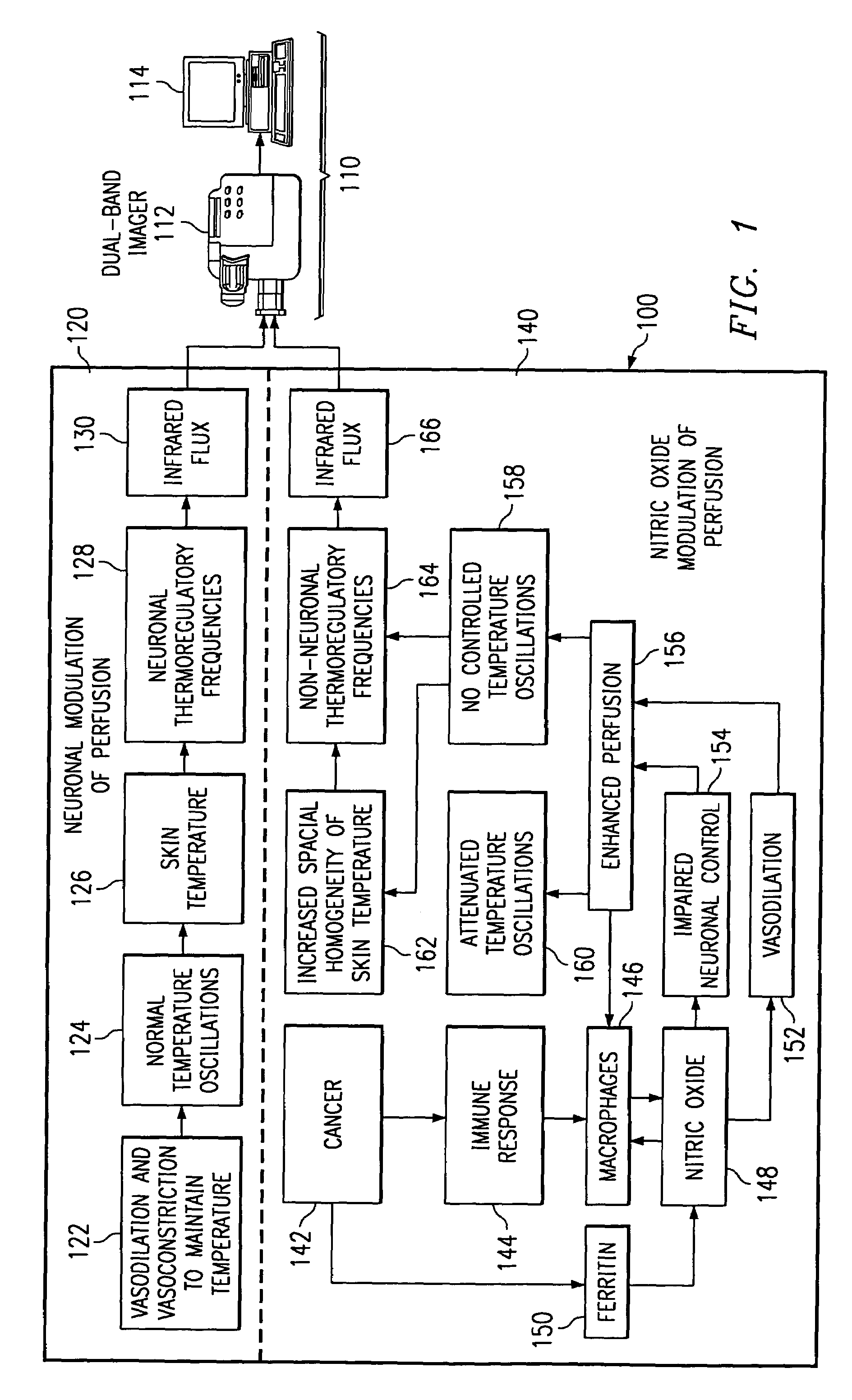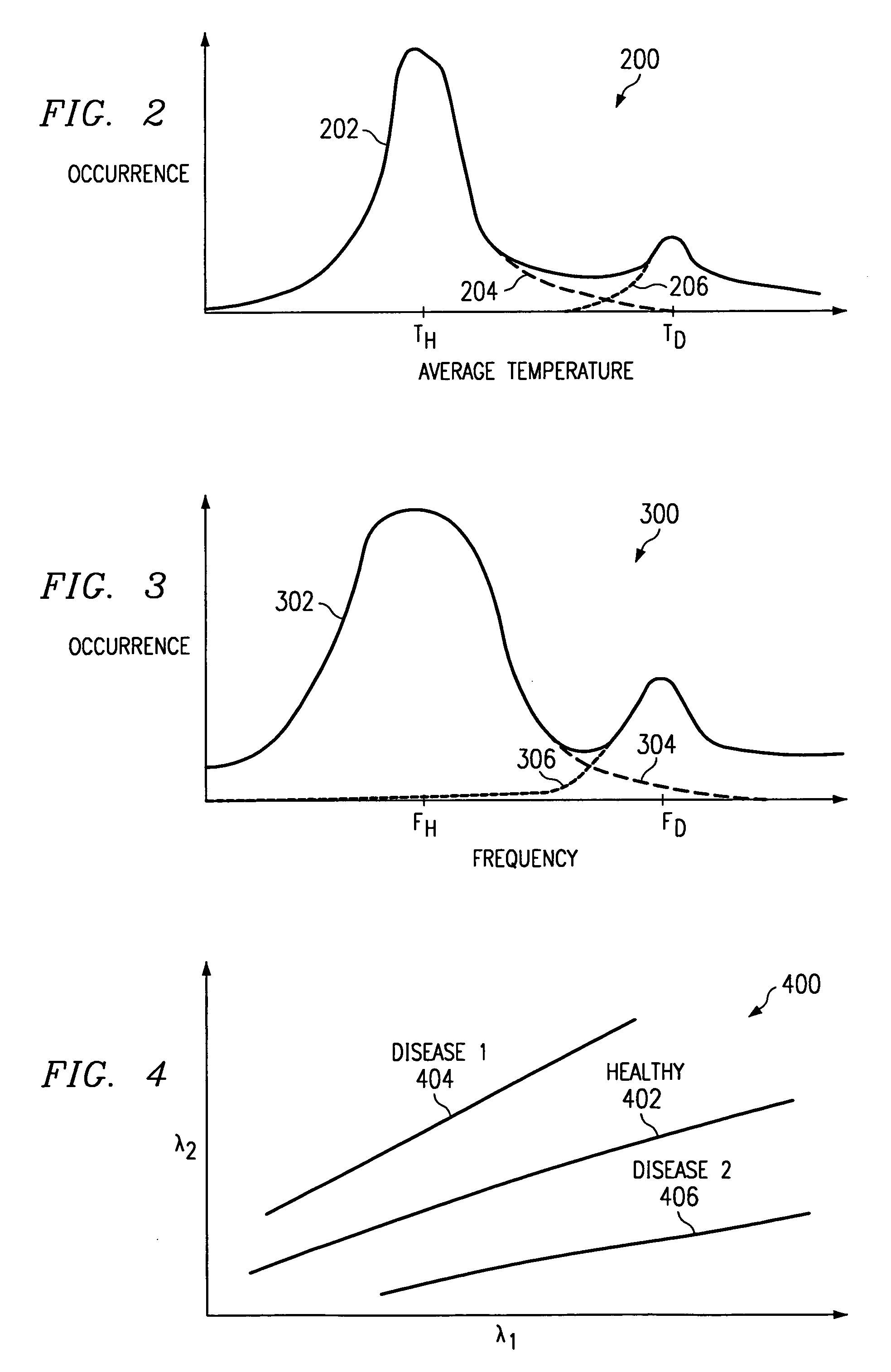Method of and apparatus for detecting diseased tissue by sensing two bands of infrared radiation
a technology of infrared radiation and infrared radiation, which is applied in the field of infrared radiation sensing methods and apparatuses for detecting diseased tissue, can solve the problems of insufficient quantity of ir imagers, breast cancer is very susceptible to detection, and changes in temporal or periodic perfusion, so as to achieve enhanced contrast in the two series of ir images
- Summary
- Abstract
- Description
- Claims
- Application Information
AI Technical Summary
Benefits of technology
Problems solved by technology
Method used
Image
Examples
first embodiment
[0031]The first embodiment then finds the average temperature value for each of these subareas. This is done for each individual thermal image in both the first and the second series of thermal images resulting in first and second pluralities of average temperature values. These first and second pluralities of average temperature values are then analyzed in view of FIG. 2. FIG. 2 illustrates a histogram showing all of the average temperature values for the first plurality of average temperature values 200. Curve 202 is the composite curve showing the average temperature values for skin overlying both healthy and diseased tissue. Curve 204 corresponds to the average temperature values for the skin overlying a healthy region of tissue. Curve 204 therefore corresponds to skin whose underlying tissue is thermally regulated by neuronal control of blood perfusion. The peak temperature value for this healthy tissue is denoted TH. In regions of skin overlying diseased or cancerous tissue, t...
second embodiment
[0033]As each of the first and second series of IR images is preferably taken periodically, TRFs can be determined. the present invention makes use of these TRFs. FIG. 3 illustrates a TRF histogram for both healthy and diseased tissue 300. Curve 302 is a composite for both the healthy and diseased tissue while curve 304 corresponds to healthy tissue and curve 306 corresponds to diseased tissue. Curve 304 for healthy tissue reflects neuronal control blood perfusion and generally has a frequency of between 10 and 700 milliHertz. In contrast, curve 306 for diseased tissue reflects NO-based control of blood perfusion and has a higher frequency, generally in the range of 0.8 to 2.0 Hz.
[0034]The second embodiment makes use of the differences in TRFs by finding the contributing frequency for each subarea in the first series of thermal images. This contributing frequency may be determined by analyzing the average temperature value for a subarea based on the known periodic nature of the firs...
fourth embodiment
[0037]The radiance measurements of healthy skin taken for the fourth embodiment may be made as a function of integration time for the dual-band IR imager 112, the temperature of the skin and tissue being imaged, or a combination thereof. The temperature of the skin and tissue can be varied by directing either a warming or a cooling stream of air on the skin and tissue resulting in thermal stress to the skin and tissue. Alternatively, this thermal stress may be induced by directing a flow of water vapor to the skin and tissue. While this thermal stress finds particular application with the fourth (and fifth) embodiments, it can readily be used in conjunction with the other embodiments as well.
[0038]Due to the oscillatory nature of thermal regulation, the sensitivity of the fourth (and fifth) embodiments can be increased. By finding the contributing frequency for each of the subareas, the correlation between the two series of thermal images can be made at neuronal frequencies or at NO...
PUM
 Login to View More
Login to View More Abstract
Description
Claims
Application Information
 Login to View More
Login to View More - R&D
- Intellectual Property
- Life Sciences
- Materials
- Tech Scout
- Unparalleled Data Quality
- Higher Quality Content
- 60% Fewer Hallucinations
Browse by: Latest US Patents, China's latest patents, Technical Efficacy Thesaurus, Application Domain, Technology Topic, Popular Technical Reports.
© 2025 PatSnap. All rights reserved.Legal|Privacy policy|Modern Slavery Act Transparency Statement|Sitemap|About US| Contact US: help@patsnap.com



